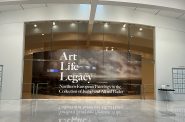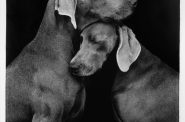MAM’s big acquisition part of a bigger picture

John Singleton Copley’s Alice Hooper, an important new Milwaukee Art Museum acquisition. Photo courtesy of MAM.
William Rudolph arrived at the Milwaukee Art Museum as curator of American art last February. By spring, he’d arranged one of the biggest acquisitions in the Museum’s history.
John Singleton Copley’s Alice Hooper is now on view in the American galleries in the north end of the museum. The American Colonial portrait, from 1763, depicts the 17-year-old daughter of a wealthy Massachusetts merchant. Her distinct face, though not exactly beautiful, appeals for its suggestions of poise and self-possession. A ruby necklace and luxurious gown speak of her social position. Her backdrop is a fantasy garden, linked to the figure through water falling from an urn fountain. The exquisitely rendered water and lace demonstrate the talent that allowed the self-taught Copley (1738-1815), son of a dockworker, to break into the society portrait business in a big way in his early 20s.
One member or another of the extended Hooper clan held the piece, which was widely known and prized, until MAM acquired.
“I realized that we didn’t own a Copley,” Rudolph said. “I knew where one was. It’s the great missing link in our collection.”
Hirschl and Adler, an important New York dealer, had the portrait for safekeeping for several years.
“I’d visited it,” Rudolph said. “It was hanging in the president’s office and not really for sale.”
The Worcester (Mass.) Museum of Art, where Rudolph worked previously, is in the painter’s back yard and had plenty of Copleys, so Rudolph didn’t need Alice. When he arrived here and saw the Copley hole in MAM’s extensive American collection, Rudolph inquired about her status.
“The family had only just decided to sell it,” Rudolph said. “It all happened very fast in the spring.”
To my eye, the painting looked freshly restored. Not so, Rudolph said.
“It’s in freakishly amazing shape,” he said. “It apparently never hung over a fireplace. And because it was in private hands, it escaped the first wave of conservation attempts in the 1930s. The whole surface is untouched, except for one or two little touch-ups.”
Its place in the collection aside, Rudolph adores this painting. He visited it often in the vault over the summer, before it went on public view.
“It looks good even under the fluorescent light,” he said. “It’s wonderful to see it on a wall and in good light.”
Copley was one of many Colonial portrait painters competing for a piece of the action. He turned out to be the best, even though many of the immigrant artists had the advantage of serious training in Europe.

Alice’s father, Robert King Hooper, in a J.S. Copley portrait. Image courtesy of the Pennsylvania Academy of the Fine Arts.
Rudolph explained that these fellows were as much businessmen as artists. They all had print books showing various European master portraits. The patron chose the setting and the costume, with advice from the artist. It wasn’t so different from those fake backdrops photographer used to pull down in pre-digital days (presto, here’s you at the Grand Canyon). The engraving books and the array of available costumes were parts of an artist’s sales pitch to prospective clients.
“That dress appears in several Copley portraits, so it was probably the property of the artist,” Rudolph said. “Copley had an engraving book like everyone else, but Copley puts some thought into it. He makes his quotations more than routine.”
Having his sitter’s hand reach out to just graze the falling water exemplifies the imagination that sets Copley apart. Thus the background becomes connected to the personality. At the same time, the flowing water is a symbol of sexual love and fidelity.
“This is her coming-out picture and her engagement announcement picture,” Rudolph said. “It has lots of marriage imagery. The obelisk fountain — with not one, but two openings — is phallic. She’s just 17, but she’s all pushed up to show a little cleavage. She’s fashionable, but fairly modest. Copley presents her as someone who will multiply and be a good mother.”
The specificity of the modeling of the face also sets Copley apart. Rudolph made the point by comparing Alice to nearby portraits by Copley contemporaries. Most of the others are generic, mask-like. The could be anyone. Alice Hooper is very much herself.
“The Hooper family was so happy with this portrait that they commissioned 11 others from Copley,” Rudolph said. “She is definitely her father’s daughter.”
This painting, lovely as it is, has certain flaws in proportions and geometry of the body. The shoulders are just a little off. To Rudolph, this is part of the work’s charm.
“Because there were no art schools, he learned anatomy by looking at other artworks,” Rudolph said. “Many of his works show a mix of sophistication and awkwardness. Here he’s hitting his stride and it’s not so apparent. That’s what I love about him — he figured out how to do it. He made his own anatomy book.”
Copley turned himself into Boston’s most important artist, but that wasn’t enough for him. In 1775, he went to England and found himself very much at home in the company of well-trained artists. He could take life-drawing classes. He went to Italy to see the masters first-hand. It made a difference.
“His whole family came over to England in 1776,” Rudolph said. “They were loyalists. The tea dumped into Boston harbor belonged to Copley’s father-in-law.”
The result of the reunion was The Copley Family, a stunning group portrait and Copley’s masterpiece. The artist depicts himself with his sketchbook. He went on to become a renowned in England, was titled, and became a member of the House of Lords. Not bad for a kid from the Boston docks.
The blockbuster purchase, along with the installment of Rudolph as MAM’s first curator of American Art, puts a new emphasis on earlier American art, which has been a footnote at MAM. The museum and its predecessor, the Layton Art Gallery, have collected it since 1888.
Rudolph is planning an extensive re-installation of this work in 2013. He regards the historical backgrounds and the stories of the people involved, both sitters and artists, as part and parcel of the art experience. He is working on new signage and support materials to tell those stories.
The American art makeover relates to an even bigger rethinking of the Saarinen War Memorial and Kahler addition on the north end of the museum complex. Recent emphasis, naturally, has been on the instantly iconic Calatrava addition, now amid a 10th-anniversary celebration exhibition. During a walk-through a few weeks ago, chief curator Brady Roberts said that the time has come to re-open lake views in the older buildings and raise the museum experience in them to the Calatrava level. That effort will, no doubt, be integrated with the solution to recently disclosed structural and water issues on the north end and the re-installation of the early American collection.
We view artworks one piece at a time, but Alice Hooper is an important part of a much bigger picture at the Milwaukee Art Museum.
Art
-
Exhibit Tells Story of Vietnam War Resistors in the Military
 Mar 29th, 2024 by Bill Christofferson
Mar 29th, 2024 by Bill Christofferson
-
See Art Museum’s New Exhibit, ‘Portrait of the Collector’
 Sep 28th, 2023 by Sophie Bolich
Sep 28th, 2023 by Sophie Bolich
-
100 Years Of Memorable Photography
 Sep 18th, 2023 by Rose Balistreri
Sep 18th, 2023 by Rose Balistreri

















The story for MAM gets worse. It appears they overpaid for art from a painter who rejected the Bill of Rights and everything for which America stands. From reader comments in the JS’ reporting about the “Copley” acquisition:
“This Copley is old news.
Mary Louise fails to mention that this painting was offered at Christie’s NY in 2006 with an estimate of $1.2 to $1.8 million with no buyers.
Someone made out on this deal and it wasn’t Milwaukee!”
Tom, this information should have been included in the review.